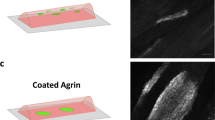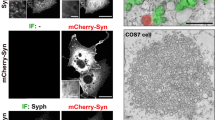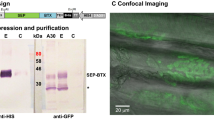Abstract
An early event in the formation of neuromuscular junctions in tissue cultures of neurones and muscle cells is an accumulation of acetylcholine receptors (AChRs) in the postsynaptic membrane1–5. As well as direct neuronal contact, AChR cluster formation can also be induced by certain soluble factors extracted or released from neurones6–8, by isolated basal lamina material9 or by a piece of degenerating nerve10. These experiments suggest that certain ‘trophic factors’ released by the neurones or the neuronal cell surface itself may cause the receptor clustering. On the other hand, stable AChR clusters are also present in pure muscle cultures without neuronal influence1,10–13, which indicates that an interaction between the muscle and an exogenous cue existing on the substrate or in the medium may be sufficient to trigger the mechanism for the clustering of AChRs in the muscle. Here we report the effect of charged latex beads on the formation of AChR clusters in cultured muscle cells. Our results clearly indicate that AChR clusters form specifically at the contacts with polylysine-coated beads. Furthermore, these beads suppressed clusters that formed in the non-contact area before the introduction of the beads.
This is a preview of subscription content, access via your institution
Access options
Subscribe to this journal
Receive 51 print issues and online access
$199.00 per year
only $3.90 per issue
Buy this article
- Purchase on Springer Link
- Instant access to full article PDF
Prices may be subject to local taxes which are calculated during checkout
Similar content being viewed by others
References
Anderson, M. J., Cohen, M. W. & Zorychta, E. J. Physiol., Lond. 268, 731–756 (1977).
Frank, E. & Fischbach, G. D. J. Cell Biol. 83, 143–158 (1979).
Peng, H. B., Nakajima, Y. & Bridgman, P. C. Brain Res. 196, 11–31 (1980).
Cohen, M. W. & Weldon, P. R. J. Cell Biol. 86, 388–401 (1980).
Kidokoro, Y., Anderson, M. J. & Gruener, R. Devl Biol. 78, 464–483 (1980).
Podleski, T. R. et al. Proc. natn. Acad. Sci. U.S.A. 75, 2035–2039 (1978).
Christian, C. N. et al. Proc. natn. Acad. Sci. U.S.A. 75, 4011–4015 (1978).
Jessell, T. M., Siegel, R. E. & Fischbach, G. D. Proc. natn. Acad. Sci. U.S.A. 76, 5397–5401 (1979).
Rubin, L. L., Gordon, A. S. & McMahan, U. J. Soc. Neurosci. Abstr. 6, 330 (1980).
Jones, R. & Vrbova, G. J. Physiol., Lond. 236, 517–538 (1974).
Sytkowski, A. J., Vogel, Z. & Nirenberg, M. W. Proc. natn. Acad. Sci. U.S.A. 70, 270–274 (1973).
Fischbach, G. D. & Cohen, S. A. Devl Biol. 31, 147–162 (1973).
Bekoff, A. & Betz, W. J. Science 193, 915–917 (1976).
Peng, H. B. & Nakajima, Y. Proc. natn. Acad. Sci. U.S.A. 75, 500–504 (1978).
Lee, C. Y. A. Rev. Pharmac. 12, 265–286 (1972).
Ravdin, P. & Axelrod, D. Analyt. Biochem. 80, 585–592 (1977).
Walter, R. J., Berlin, R. D., Pfeiffer, J. R. & Oliver, J. M. J. Cell Biol. 86, 199–211 (1980).
Burry, R. W. Brain Res. 184, 85–98 (1980).
Author information
Authors and Affiliations
Rights and permissions
About this article
Cite this article
Peng, H., Cheng, PC. & Luther, P. Formation of ACh receptor clusters induced by positively charged latex beads. Nature 292, 831–834 (1981). https://doi.org/10.1038/292831a0
Received:
Accepted:
Issue Date:
DOI: https://doi.org/10.1038/292831a0
This article is cited by
-
The Biophysical Society of Hong Kong (BPHK): past, present, and future
Biophysical Reviews (2019)
-
Microsphere attachment induces glycoprotein redistribution and transmembrane signaling in theChlamydomonas flagellum
Protoplasma (1998)
-
Intercellular communication that mediates formation of the neuromuscular junction
Molecular Neurobiology (1997)
-
Novel form of growth cone motility involving site-directed actin filament assembly
Nature (1992)
-
Nicotinic receptor-associated 43K protein and progressive stabilization of the postsynaptic membrane
Molecular Neurobiology (1992)
Comments
By submitting a comment you agree to abide by our Terms and Community Guidelines. If you find something abusive or that does not comply with our terms or guidelines please flag it as inappropriate.



